The content of the article
Why does not Kalanchoe bloom, but only leaves grow? Such a question arises in many gardeners. When buying in the store the seller assures that the care is very simple. So people are relaxing, not really caring about the plant.
Sorry, there will be no magic. Without care, only dandelions bloom. And about Kalanchoe have to dance. Not so long, but if you need a result - a lush flowering, then some time will have to be allocated.
What provokes the flowering of Kalanchoe? Just a few factors:
- shine
- water
- temperature
- a haircut
Here we consider all the points in detail.
Lighting
Most people think that plants need a lot of sunlight for flowering. This is true, but only in part. Kalanchoe likes bright lighting. But here's the catch: the plant lays flower buds only in conditions of short daylight hours. That is, no more than 10 hours.
How to get out of the situation? Very simple.To do this, you need a dark shelter. It can be a cone of thick paper, a cardboard box, or even a piece of light-tight fabric. For example, black covering material. Any of the above need to cover the Kalanchoe at 19.00, and in the morning, at 7.00 open.
By the way, Kalanchoe is not afraid of direct sunlight. Therefore, it can be safely grown on the southern or western windows.
On the north windows, the plant may simply not have enough light. The plant will begin to stretch, the leaves are crushed and fall off. So it is necessary to acquire special lamps, or come up with another way out. Otherwise, instead of a fluffy flowering bush, you will get a long skinny bald branch.
The windows facing east are ideal. There is enough bright light, plus the sun leaves after dinner. So, no additional blackout is needed.
Council Kalanchoe can be grown safely in the depths of a room. Naturally, additional lighting lamps will have to be switched on all year round.
Watering and temperature
Failure to proper irrigation regime - one of the reasons for the lack of flowering Kalanchoe. Not everyone knows that this is a succulent.And pour water as soon as the top layer of earth in the pot dries. Why should a plant strive to continue its genus with flowers and seeds, if there is always enough liquid? You can easily increase the green mass.
In winter, the apartment is almost always hot and dry air. In such conditions, flower buds are not laid. It is necessary to change the temperature policy a little bit, in order to admire the fabulous bunch.
In the natural environment of Kalanchoe autumn and winter is cool, the earth is dry. In spring and summer there are regular rains, the air is warm and humid. Therefore, when growing in a room, you need to strive to create a similar microclimate. I.e:
- Autumn gradually reduce watering. Guided by the principle of dried topsoil plus another 3-4 days.
- The temperature of the ambient air is also gradually reduced, bringing to + 19-21 ° C.
- Sometimes the plant itself is sprayed, about once a week.
- With the arrival of spring watering increase, reaching the norm. But do not overdo it! Rotting roots will not contribute to flowering for sure.
- The temperature of the content is raised to + 25-27 ° C.
- Sprays increase up to 3 times a week.
Thanks to these actions in the fall will begin bookmark flower buds. In the spring, Kalanchoe wakes up and begins to actively bloom.
And further. Make good drainage in the tank. At home, Kalanchoe has become accustomed to loose rocky soil. Therefore, its roots breathe freely. And if there is a swamp in the pot, then the plant will simply get sick and die. What kind of flowers are there?
Council Water for watering is defended, but not boiled. Indeed, there is no boiled rain in nature.
A haircut
A very important point for flowering. The fact is that flowers grow only on the tips of young shoots. And what happens usually? Kalanchoe blossomed, cut and left. Let it grow as it pleases. So he wants to pull a couple of long branches. Flowers on them will never happen again.
To plant laid flower buds, you need to provoke the formation of lateral shoots. This is most conveniently done in the summer when branches are actively growing. All you need is to pinch the old tops. However, this may not be enough.
Until September, will have to regularly inspect the plant and carry out a haircut. If you let the matter take its course, the bush will not be lush. It will simply continue to grow several side branches, and by the time of flowering it will completely lose its shape.
Some flower growers do not even puzzle over the correct pinching of the shoots.They simply root small shoots in the new soil, and old plants are thrown away or left as mother liquor for the production of young shoots.
Council It is impossible to form Kalanchoe in autumn and winter. By mistake, you can cut flower buds with the tops of new shoots.
Other factors
We considered the main reasons why Kalanchoe does not bloom, but only leaves grow. But besides the direct, there may be indirect perpetrators. They also should not be discounted.
Feedings
Flowering always takes a lot of power and nutrients from any plant. And if those who grow in nature can calmly replenish their reserves of the earth, then room has to be helped. After all, there is no normal amount of trace elements in the pot.
Any fertilizer of complex composition will be suitable for top dressing. It is not necessary to look for a special one for succulents. It is enough just to reduce the dosage of the universal composition. Better 2 times.
Just do not feed Kalanchoe too often. After all, it is accustomed to a very meager diet. Excess fertilizer can lead to the development of diseases or tissue necrosis.By the way, how many times per season to give kalanchoe dressing, you can’t just say so. This should be written on the packaging. We advise no more than 1 time per month. In winter and autumn, they do not fertilize at all. This is a time of rest and preparation for flowering, and excess nutrition will break the normal cycle. Kalanchoe will grow, but will not bloom.
Pot size
Some sources recommend to replace the Kalanchoe annually in a new pot. But do not explain the reason. It is interesting, for what purpose does the plant need another pot each time? Not otherwise, as a tribute to fashion. How else to explain such a regular invasion of the root system? And where will you have to wait for flowers, when the plant only does what adapts?
Do not once again open the root system and replace the Kalanchoe annually. This is required only when the roots are really cramped in the pot. And it is desirable to carry out the entire procedure in the summer, after the end of the next flowering.
In principle, it is possible to make a transplant in the fall, but only until the period of hibernation and flower budding starts. And do not choose a pot that is much larger than the previous one in diameter.In too free capacity, Kalanchoe will be lazy and will not bloom.
Pests
In our climate among insects there are no Kalanchoe lovers. But the aphid doesn’t understand which continent its food came from. She often enjoys the juice of plump leaves. As a result, the plant becomes weakened, it has no strength left to bloom.
If March has come, and the buds are not yet visible on the calanchoe, despite the excellent conditions of detention and competent care, then carefully examine the whole plant. You need to be a very inattentive person or a complete blind man, so as not to notice the uninvited guests. Moreover, the appearance of Kalanchoe when infecting aphids always makes one want something better.
When pests are detected, the plant is immediately bathed in a solution of whole soap. At the same time be sure to cover the soil in a pot with foil or dense polyethylene.
With a strong defeat, and this happens even in the most diligent owners, soap will not help. Will have to use insecticides. Of course, chemical products, but here you need to decide what is more important. The choice is between the terry principles of organic farming and the health (flowers) of Kalanchoe.First, save Kalanchoe from death, and only then rebuke yourself for using industrial means. Do not forget about the basic care.
Diseases
Kalanchoe almost nothing hurts. But sometimes it can be attacked by bacteria or fungal spores. In most cases, the plant will cope on its own if it does not interfere. For example, excessive watering. Because the roots are choking, the green mass is weakening, and the sores develop. There will be no flowering anyway.
First you need to help Kalanchoe to recover and recover, and then wait for the buds. For this you need:
- Treat the shrub with any systemic fungicide. It will help stop the spread of the disease.
- Adjust the irrigation schedule, because most of the diseases of Kalanchoe are different rot from moisture overload.
- Change the contaminated soil in a pot to a new one.
- Be sure to inspect the root system. If necessary, trim the rotten roots and burn them with the usual medical green paint.
- Once every 8 days spray Kalanchoe with a solution of any adaptogen. This may be aloe juice, zircon, epin.
The last item is performed until full recovery of Kalanchoe. And they try to care for him carefully in the future, but without fanaticism.Sometimes excessive care does more harm than good. The plant will be useful to take a break from the excessive love of the owners.
In general, it is very easy to find the reason why Kalanchoe does not bloom, but only leaves grow. It is enough to take a closer look at your plant and follow the recommendations for care. Then it will take quite a bit of effort, and as a result there will be chic hats of inflorescences that will please the hosts for at least 5 months.
Video: proper care for Kalanchoe

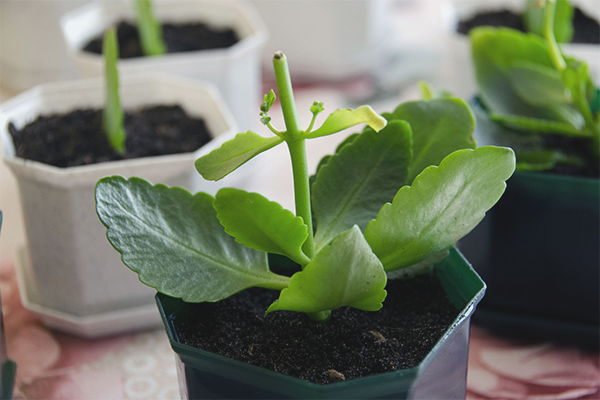
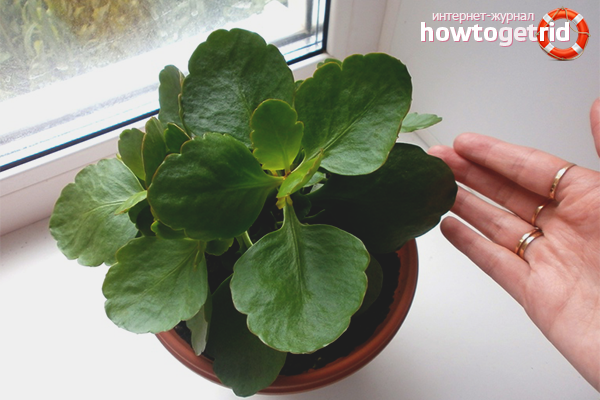

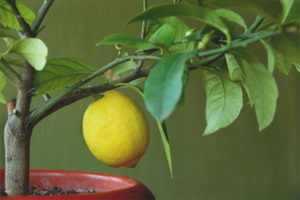
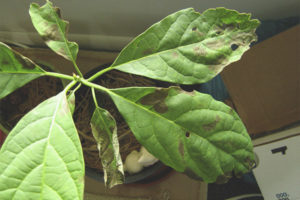


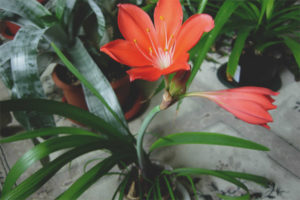

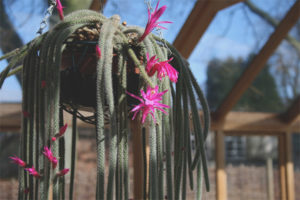
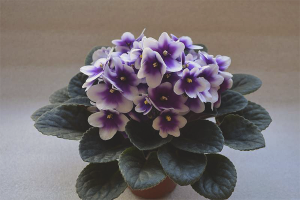
To send